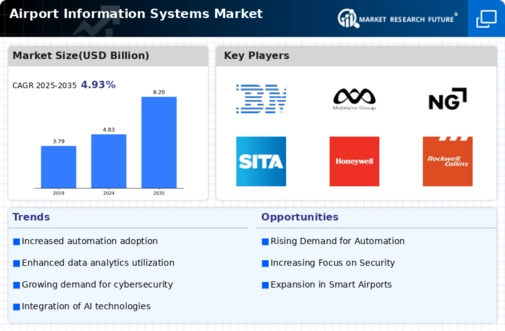Market Analysis
In-depth Analysis of Airport Information Systems Market Industry Landscape
The complexity of contemporary air travel, technological advances, and rising passenger expectations are changing the airport information systems business. As airports worldwide improve efficiency, security, and passenger experience, innovative information systems are in demand. Airports must use digital technologies to simplify operations, which drives market dynamics. Technology in airport information systems includes passenger processing, luggage handling, and security. These systems coordinate airport operations including check-in, boarding, luggage tracking, and security inspections. Rapid technological change drives the airport information systems industry. Airports are transforming using cloud computing, AI, and the IoT to improve operational efficiency and passenger experiences. Cloud technologies help airports to quickly adjust to changing situations due to their flexibility, scalability, and real-time data access. Predictive analytics using AI and IoT help airports avoid delays and security risks. The market is always pushing for novel technology that may change how airports function and service passengers. The airport information systems industry is driven by rising air traffic and passenger expectations. Airports must effectively handle more passengers while providing a smooth and comfortable ride. Airport information systems are including passenger processing technologies like check-in kiosks, self-service luggage drops, and biometric verification. These solutions speed up passenger travel, reduce lines, and improve satisfaction. Thus, airports are investing in solutions to meet rising air travel demand while maintaining good service standards. Airport information system market dynamics are driven by security. Airports must constantly improve security and follow strict laws. To protect passengers and airport infrastructure, airport information systems increasingly include biometric identification, video surveillance, and danger detection technology. Thus, airports' need to adapt to new security risks and meet international aviation security requirements affects market dynamics. Airport information system market dynamics depend on interconnectivity and interoperability. As complex ecosystems, airports include airlines, ground handlers, and government organizations. Airport efficiency requires seamless communication and data exchange between various institutions. Standardized and integrated information solutions that enable airport ecosystem cooperation and data interchange are being promoted in the market. Established and rising technology suppliers compete in the airport information systems industry. Companies often use strategic alliances, mergers, and acquisitions to extend their product lines and geographic reach. Technological skills and the capacity to provide complete solutions for airports of all sizes stimulate competitiveness. North American economies' superior aviation infrastructure and consumer awareness have shaped global aviation. However, with many technical advances, Asia Pacific is becoming a major aviation player. This business is boosted by regional customers' greater purchasing power. Rapid industrial development and commercialization have raised consumer disposable income, causing this financial growth. In conclusion, technology advances, passenger expectations, security imperatives, and interconnectedness impact airport information system market dynamics. Innovative and integrated information systems are in demand as airports improve operational efficiency and customer experience. Airport information systems stakeholders must manage these dynamic elements to offer solutions that satisfy the aviation industry's changing demands and enhance airport services globally.









Leave a Comment